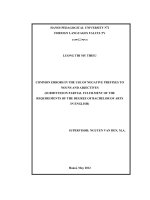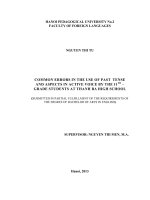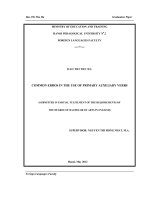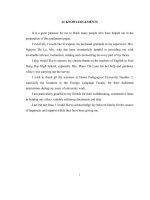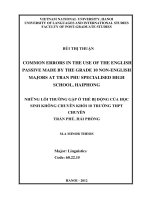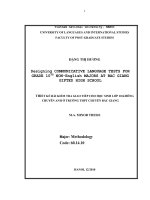Common errors in the use of the english passive made by the grade 10 non english majors at tran phu specialised high school, hai phong
Bạn đang xem bản rút gọn của tài liệu. Xem và tải ngay bản đầy đủ của tài liệu tại đây (714.27 KB, 62 trang )
VIETNAM NATIONAL UNIVERSITY, HANOI
UNIVERSITY OF LANGUAGES AND INTERNATIONAL STUDIES
FACULTY OF POST-GRADUATE STUDIES
BÙI THỊ THUẬN
COMMON ERRORS IN THE USE OF THE ENGLISH
PASSIVE MADE BY THE GRADE 10 NON-ENGLISH
MAJORS AT TRAN PHU SPECIALISED HIGH
SCHOOL, HAIPHONG
NHỮNG LỖI THƯỜNG GẶP Ở THỂ BỊ ĐỘNG CỦA HỌC
SINH KHÔNG CHUYÊN KHỐI 10 TRƯỜNG THPT
CHUYÊN
TRẦN PHÚ, HẢI PHÒNG
M.A MINOR THESIS
Major: Linguistics
Code: 60.22.15
HANOI - 2012
VIETNAM NATIONAL UNIVERSITY, HANOI
UNIVERSITY OF LANGUAGES AND INTERNATIONAL STUDIES
FACULTY OF POST-GRADUATE STUDIES
BÙI THỊ THUẬN
COMMON ERRORS IN THE USE OF THE ENGLISH
PASSIVE MADE BY THE GRADE 10 NON-ENGLISH
MAJORS AT TRAN PHU SPECIALISED HIGH
SCHOOL, HAIPHONG
NHỮNG LỖI THƯỜNG GẶP Ở THỂ BỊ ĐỘNG CỦA HỌC
SINH KHÔNG CHUYÊN KHỐI 10 TRƯỜNG
THPT CHUYÊN TRẦN PHÚ, HẢI PHÒNG
M.A MINOR THESIS
Major: Linguistics
Code: 60.22.15
Supervisor: NGUYÔN HUYÒN MINH, M.A.
HANOI - 2012
TABLE OF CONTENTS
Table of contents
Abbreviations
Lists of tables and charts
PART I - INTRODUCTION
I. Rationale of the study
6
II. Objectives of the study
7
III. Scope of the study
7
IV. Methods of the study
8
V. Organization of the study
8
PART II – DEVELOPMENT
CHAPTER I – LITERATURE REVIEW
9
1. An overview of voice in English
9
1.1. Voice
9
1.2. Active and Passive Voice
10
1.3. English passive voice
12
1.4. English passive in comparison with Vietnamese passive
26
2. Error and error analysis.
28
2.1. Definition of error
28
2.2. Error analysis
29
2.3. Causes of errors
30
CHAPTER II – METHODOLOGY
33
1. Subject of the study
33
2. Setting
33
3. Research tools
34
4. Data collection procedures
36
i
CHAPTER III – DATA PRESENTATION AND DISCUSSION
37
1.Written test
37
2.1. Written test results
37
2.2. Some common errors made by the students
37
2. Questionnaire for students
47
2.1. Questionnaire results
47
2.2. Data analysis
47
3. Probable causes of the errors
50
4. Measures to overcome these errors
52
PART III – CONCLUSION
55
References
Appendix 1
Appendix 2
ii
Abbreviations
E.A: Error analysis
Lists of tables and charts
Chart1: The change in the position of constituents in passive transformation
Table 1: Passive verbs in different tenses
Table 2: The statistic of correct answers
Table 3: Types of errors found in the study
Table 4: Unnatural translation due to unchanging the voice
Table 5: Errors of forming the past participle
Table 6: Wrong translation samples with “bị, được”
Table 7: Errors of using some special passive voice structures
Table 8: List of special structures
Table 9: Unnatural translation with some special structures
iii
PART I – INTRODUCTION
I. Rationale of the study
According to statistics of recent studies, people who master English will
see greater possibilities of success in doing research, getting promotion, and
doing business. They also confirm the relationship between English
competence and high salary or increased trade. Accordingly, the importance
of English is undeniable because it has become the most popular language in
all over the world. This is the reason why English is now an obligatory
subject in every high school in Vietnam.
In fact, many students are finding this subject more difficult than they
used to think. A lack of grammar can be one of major obstacles to mastering
this second language. There is an irrefutable fact that grammar is an integral
part of every language, and English grammar is not an exception. How would
you study other specific fields in English without mastering grammar?
English grammar includes many beautiful and unique aspects which we
cannot find in other languages. To Vietnamese learners, English grammar
sometimes makes them confused due to the differences between English and
our mother–tongue. As a result, they have a lot of difficulties in
communicating, especially in reading and writing in English.
The passive voice is considered to be one of the hardest grammatical
items for Vietnamese learners to master. Although there are a lot of pages,
books, chapters which have been written about the passive voice, many
students of English still have trouble explaining its usage in understandable
ways. In my experience in teaching English at Tran Phu Specialised High
School in Hai Phong City, students often make common errors in using
passive voice and causes of these errors have not been discovered yet.
The analysis of students’ errors is of great importance in teaching English.
It helps teachers identify students’ strategies of language learning and their
1
level of proficiency so that teachers can find out suitable ways to improve
current situations.
These are the reasons why I have decided to carry out a small study on
common errors in the use of the English passive made by the grade 10 nonEnglish major students at Tran Phu Specialised High School.
II. Objectives of the study:
The study is aimed at firstly achieving deeper understanding of English
passive voice, and above all, figuring out typical errors made by the students
at Tran Phu Specialized High School in using passive voice. Besides, the
thesis is to find out causes of the typical errors in using passive voice and
working out solutions to teaching students passive voice effectively.
Hence, the research is to answer the following questions:
+ What are the typical errors made by non – English majors at Tran Phu
Specialized High School?
+ What are probable causes for these errors?
+ What are possible solutions to help the students overcome these errors?
III. Scope of the study:
The study is focused on the passive voice. However, it is not my
ambition to cover every issue of the passive voice. Within this small thesis, I
desire to give readers some aspects of passive voice: a description of the
passive voice sentence, uses, passive transformation constraints, and the
formation of passive voice. A comparison between English passive sentences
and their Vietnamese equivalents is also mentioned.
Moreover, second language learners are various and different in the
way of making errors. However, because of limited size, the study will
concentrate on giving an analysis of errors made by only 70 students from
two non-major classes at Tran Phu Specialised High School.
2
IV. Methods of the study:
This study is a quantitative survey research. In fact, a combination of
data instruments is employed in an attempt to attain all the objectives above.
All the theory is attested by the exact data collected from a written test and a
questionnaire for students which is presented in the later parts of the study.
From the analysis of the data, the problems will be found and the solutions
will be given.
V. Organization of the study:
The study consists of three parts: Introduction, Development and
Conclusion.
- Part I (Introduction) shows the rationale, the objectives, the scope, the
methods and the organization of the study.
- Part II (Development) includes three chapters. Chapter I reviews the
literature related to English passive voice and error analysis. Chapter II
provides the methodology which takes a closer look at the subjects, the
background, and the methods in use. Chapter III analyzes actual errors made
by the subjects. This chapter also discusses the causes of these errors and
suggests some solutions to the improvement of teaching this grammatical
item.
- Part III (Conclusion) summarizes the content of the research and gives
some suggestions for further study.
3
PART II – DEVELOPMENT
CHAPTER I – LITERATURE REVIEW
1. An overview of voice in English.
1.1. Voice
Verb plays a vital role in English. It involves many verbal categories such
as mood, tense, aspect, and voice. Among these aspects, it appears that voice
is one of the most dominant parts of English grammar. Accordingly,
numerous grammarians have studied voice and defined what voice is in their
own way. Followings are some typical definitions, which are usually used in
teaching and learning English.
“Voice is a grammatical category which makes it possible to view the
action of sentence in two ways without change in the facts reported.”
(Randolph Quirk, 1973:98)
“Voice is a form or set of forms of a verb in which either person or thing
that does something is the subject of the verb (the active voice) or the person
or thing that is affected by the action of the verb is the object (the passive
voice)”
(The Oxford Advanced Learner’s Dictionary)
All things considered, the above definitions express the relationship
between the subject and the action of the verb. To illustrate this relationship,
consider the following example:
Jim’s daughter drew that picture.
That picture was drawn by Jim’s daughter.
In the first sentence, the subject “Jim’s daughter” is the person who
performs the action “draw”. Conversely, in the second sentence, “that picture”
does not perform the action. “That picture” is created by the action of
drawing.
1.2. Active and Passive Voice
4
English has two voices, the active voice and the passive one, to indicate the
relationship between the subject and the action described by its verbs.
(Illinois, R. 397:1985)
1.2.1. Active Voice
The active voice shows that the person or thing denoted by the subject of
the sentence is the agent (doer) of the action expressed by the predicate it acts.
E.g.: About 30 million people are watching this program. (a)
Sentence (a) is said to be an active sentence since the form of verb is in the
active voice. The subject “about 30 million people” is performing the action
of “watching”.
1.2.2. Passive Voice
“The passive voice serves to show that the person/thing denoted by the
subject of the sentence is not the agent (the doer) of the action expressed by
the predicative verb but is the object of this action. The subject of a passive
verb does not act but it acted upon, it undergoes an action”.
(Gordon, E.M., 1972:25)
E.g.: This program is being watched by about 30 million people. (b)
On the contrary to sentence (a), the inanimate subject “this program” in (b)
cannot perform the action of watching. Actually, it is affected by this action.
The performer is now put at the end of the sentence after “by phrase”.
Sentence (b) is treated in grammar as a passive sentence.
1.2.3. Differences between active voice and passive voice
Comparing active voice and passive voice, several marked distinctions are
noticed. In terms of structure, the crystal difference is the verb form. The
following instances will elaborate this:
John bought this clock. (c)
This clock was bought by John. (d)
5
Look at the sentences, in (c), the main verb is in active form “bought” while in
(d)- the corresponding passive one of (c), verb of active sentence (c) is
replaced by the verb “to be” and the past participle of the active verb.
The second major difference is the order of the components in the sentence.
The change in the position of the constituents can be pictured as followed:
Active S
(John)
Passive S
(this clock)
Active verb
(bought)
Passive verb
(was bought)
Active O
(this clock)
Optional agent
(by John)
Chart1: The change in the position of constituents in passive transformation
The third difference is that unlike the active sentence, in passive
construction, it is easy to leave out the person or thing doing the action if the
speaker does not want to specify who the agent is.
In addition, the two above sentences also differ semantically and lexically.
In (c) the focus is on “John” while in (d), the emphasis is on “this clock”. The
focus has changed from “John” to “this o’clock”. That is to say the
information which is more important to be informed will be made the subject
of a sentence to draw attention.
Therefore, the active construction is often considered to be more direct,
powerful and vivid as the performer is known and placed at the initial. In
contrast, the passive voice is supposed to be indirect, unemphatic, and vague
because the performer is likely to be unnamed or named only in a minor
sentence element.
Moreover, active and passive sentence sometimes are not totally equal in
meaning. There are shifts in the range of meaning especially when the active
6
sentence contains quantifiers. Compare the paired active and passive
sentences below to see different interpretations to be given.
“Six people in the room read three novels.” (i.e. it may be up to 18 novels
read by six people.)
“Three novels were read by six people in the room.” (i.e. only three specific
novels that six people read.)
1.3. English passive voice
1.3.1. Description of English passive voice
1.3.1.1. Procedures
The structure of the passive voice is very simple:
Subject + auxiliary verb (be) + main verb (past participle)
In active sentences, the thing doing the action is the subject of the sentence
and the thing receiving the action is the object. In passive sentences, the thing
receiving the action is the subject of the sentence and the thing doing the
action is optionally included near the end of the sentence. The main verb
is always in its past participle form.
1.3.1.2. The verb forms
Like an active verb, a passive verb can occur in different verb tenses. The
passive verb forms can be systematized as follows:
7
Tense
Present
Aspect
Past
Am
Simple
Progessive
Is
Was
+ Pii
Were
Am
Was
+ Pii
Are
+ be + Pii
M+be+Pii
Shall
being+Pii
M+be+being+Pii
Were
Have
Perfect
Modal (M)
Will
+ Pii
Are
Is
Future
Will
+been+Pii Had + been + Pii
Has
+have+been+Pii M+have+been+Pii
Shall
(Thomson and Martinet, 1986:265)
Table 1: Passive verbs in different tenses
It should be noted here that the progressive forms of the present perfect, past
perfect, future and future perfect are very rarely used in the passive since we
usually avoid saying “be being” and “been being”.
E.g.: You will be doing geometry next term. (NOT: Geometry will be being
done next term.)
1.3.1.3. A preposition plus agent
The subject of an active sentence can be introduced in the corresponding
passive one by means of “by” phrase. It is notable that the subject of the active
sentence now either remains noun phrases or changes into objective pronouns.
E.g.: My daddy made this cake.
This cake is made by my daddy.
E.g.: She saw John yesterday.
John was seen by her yesterday.
8
In a passive clause, we usually use a phrase beginning with “by” if we want to
mention the agent –the person or thing that does the action, or that causes
what happens.
E.g.: All the trouble was caused by your mother.
I was shocked by your attitude.
Also, the method can be mentioned using an –ing form after “by”.
E.g.: Much of their strong taste can be removed by changing the cooking
water.
Note, however, that usually the passive is used without a by-phrase. In fact,
only about 20% of passive sentences mention the agent. According to Michael
Vince (34:2003), there are several reasons for this.
Agent not known:
E.g.: Mike’s motorbike was stolen last night.
If we knew who had stolen it, we would mention the name of the person. But
we do not know and the agent is not mentioned.
Agent generalized:
E.g.: Bicycles are widely used in the city instead of public transports.
If the agent is “people in general” or “you”, the agent is not mentioned.
Agent obvious:
E.g.: One protester was arrested.
It is not necessary to add the words “by the police”, because we know that it is
always the police who do this. However, it is necessary to add these words if
we want to.
Agent unimportant:
E.g.: A lot of grammar books are sold every year.
9
Exactly who sells the books is not important. If it was important, we could use
by and the name of the people or shops who sell the books.
Impersonality:
E.g.: It has been decided to reduce all salaries by 10%.
Using a passive is a way of avoiding the naming of a specific person who is
responsible for an action. In particular, in descriptions of processes, there is
emphasis on the actions performed, rather than on the people who perform
them.
E.g.: Then the packets are packed into boxes of twenty – four.
However, we can include the agent in the following situations:
When we add necessary new information.
E.g.: By tradition, any sturgeons that are caught by British ships must be
offered to the Queen.
When we want to refer back to the agent in the next clause.
E.g.:
The survivors were picked out of the water by a cruise liner which had heard
of their distress call.
I remembered being taken to the fair by my father, who rarely showed any
interests in such things.
When the agent is mentioned with proper names of famous or important
people.
E.g.: Life on the Mississippi was written by Mark Twain.
In fact, the by + agent phrase is commonly used to talk about works of arts,
well – known inventions, discoveries, historical events, and famous
achievements.
When the identity of the agent is unexpected or surprising.
10
E.g.: It’s unbelievable! This quiz was solved by a seven - year old boy.
In some cases, by is replaced by with, which is often used especially with such
past participles as: crammed, crowded, packed, and filled.
E.g.: The train was packed with commuters.
Actually, by and with are not generally interchangeable in the following
examples:
E.g.: Dave was hit by a branch. (an accident)
Dave was hit by with a branch. (a person hit him with one)
(Michael Vince, 34:2003)
Accordingly, the difference between with and by may involve the presence of
a person.
After the past participles of some stative verbs, including some which are used
like adjectives, other prepositions can be used instead of by.
E.g.: We were worried about/by her silence.
Are you frightened of spiders?
1.3.2. Constraints on the passive transformation
Although most active sentences can have corresponding passive sentence,
there still exist some exceptional active sentence that cannot have passive
transformation.
* Verb Constraints:
Not all verbs can have passive voice forms. Passive structures are not possible
with intransitive verbs which cannot have objects because there is nothing to
become the subject of the passive sentence.
E.g.: The baby cried.
According to Randolph Quirk (1985:136), in addition to copular and
intransitive verbs, some transitive verbs, called “middle” verbs, do not occur
at least in one some senses in the passive. They include:
- Verbs of possession: have, belong to, etc.
11
E.g.: She has an Alsatian dog. (NOT: An Alsatian dog is had by her.)
- Reciprocal verbs: resemble, look like, agree with, equal, mean, etc.
E.g.: She resembles a princess. (NOT: A princess is resembled by her.)
- Verbs of containing or their opposite: contain, hold, compose, lack,
comprise, etc.
E.g.: You lack tact. (NOT: Tact is lacked by you.)
- Verbs of suiting: suit, fit, become, etc.
E.g.: This coat doesn’t fit me. (NOT: I am not fitted by this coat.)
However, other state verbs especially those of volition or attitude, can easily
occur in the passive. E.g. believe, intend, know, like, love, mean, need, own,
understand, want.
E.g.:
The company is owned by an American company.
Old postcards are wanted by collectors.
In reverse, for some verbs only the passive voice is possible.
E.g.:
John was said to be a good teacher. (NOT: They said John to be a good
teacher.)
I was born in Haiphong. (NOT: My mother bore me in Haiphong.)
Moreover, it is only in the abstract, figurative use such as “go into, arrive at,
look into” and many other expressions accept the passive.
E.g.:
The engineers went very carefully into the problem. The problem was very
carefully gone into by the engineers.
The engineers went very carefully into the tunnel. (NOT: The tunnel was very
carefully gone into by the engineers.)
One more important point is that the passive is not possible for many idioms
in which the verb and the object form a close unit:
The ship set sail. (NOT: Sail was set.)
12
We changed buses. (NOT: Buses were changed.)
* Object constraints:
- With clauses as objects, sentences take the passive with “it” – subject. That
is to say clauses are introduced by anticipatory “it” and remain in post –
verbal position in the passive sentence.
E.g.:
John thought that she was attractive.
~* That she was attractive was thought by John.
However, the passive often becomes acceptable in these cases:
It was thought that she was attractive.
OR: She was thought to be attractive.
- Co-reference between a subject and a noun phrase object blocks the passive
correspondence. This constraint occurs with reflexive, reciprocal, and
possessive pronouns when co-referential to the subject. The following
sentences cannot have passive transformation:
E.g.: John could see himself in the mirror.
E.g.: We could hardly see each other in the fog.
E.g.: The woman shook her head.
* Meaning constraints:
As mentioned above, changing an active sentence into the passive or vice
versa may well make a difference not only in emphasis, but also to the scope
of negatives. Moreover, a shift of meaning may accompany shift of voice in
verb phrases containing modal auxiliaries that have more than one meaning
such as shall, will, can:
E.g.:
John can’t be taught. (i.e. He’s unable to learn.)
She can’t teach John. (i.e. She’s unable to teach John.)
1.3.3. Formation of the English passive voice
1.3.3.1. Ordinary formations:
13
There are several criteria to classify the formation of the English passive
voice. In terms of sentence pattern, passive transformations are allowed in
only three following structures:
S-V-O (-A)
S-V-Oi-Od (-A)
S-V-O-C (-A)
1.3.3.1.1.Formation from the S-V-O (-A) pattern
* The object is a noun phrase:
It is usually possible for the direct object of the active sentence to become
subject of the passive.
E.g.: She cut the cake. The cake was cut (by her).
* The object is a finite clause:
The normal passive analogue has “it” and extraposition. Another way is the
subject of the finite clause can become the subject of corresponding passive
sentence. We use these structures when we cannot say or do not need to say
who the speaker is.
E.g.: People say that Henry is in love with Claire.
It is said that Henry is in love with Claire.
OR: Henry is said to be in love with Claire.
* The object is a non – finite clause:
Non-finite clause objects without subject include verbs which take either
participle or infinitive. The passive analogue is rare with these verbs.
E.g.: I intend to go.
~* To go was intended (by me).
(Quirk & Greenbaum, 1973:365)
The exceptions are with a few verbs notably “agree, arrange, decide” only if
there is extraposition “it”.
E.g.: They decided to buy the car.
~ It was decided to buy the car by them.
14
Additionally, to certain kinds of verbs such as: agree, insist, recommend,
recommend, advise, etc., the passive can be expressed by a finite clause:
“that…should”
E.g.: He decided to sell the house.
He decided that the house should be sold.
(Thomson & Martinet, 1986:264)
1.3.3.1.2.Formation from the S-V-Oi-Od (-A) pattern:
Many verbs carry two objects in an active sentence. One object is usually a
concrete or abstract thing, the other is usually a person or sometimes both of
two objects are things. Normally, the direct object becomes the subject of the
corresponding sentence in most cases as we are more interested in people than
things. Also, the indirect object is always a noun phrase while the direct one
may be a noun phrase, a finite clause or a non – finite clause.
* The direct object is a noun phrase
When direct object and indirect object are noun phrases, the active sentence
has two passives:
E.g.: A friend gave me the information.
I was given the information by a friend.
OR: The information was given me by a friend.
Of the two passives, the second is usually replaced by the corresponding
prepositional phrase: The information was given to me by a friend.
There’s an exception, however, with the verb “wish” when normally only the
indirect object is used:
E.g.: They wished us a pleasant holiday.
~ We were wished a plesant holiday (by them).
* The direct object is a finite clause
- Where the indirect object is obligatory, the active sentence can be
passivized, with the indirect object as the subject of the passive sentence:
E.g.: John convinced me that he was right.
15
I was convinced (by John) that he was right.
(Quirk & Greenbaum, 1973:371)
- Where the indirect object is optional, the passive is normally expressed by
extra position “it”.
E.g.: John showed (me) that he was honest.
It was shown (to me) that he was an honest man.
E.g.: John mentioned (to me) that they were sick.
It was mentioned (to me) (by John) that they were sick.
( Quirk & Greenbaum, 1973:371)
* The direct object is a non – finite clause.
The subject of the non-finite clause can become the subject of a passive
superordinate clause.
E.g.: They persuaded John to see me.
John was persuaded to seem me.
( Quirk & Greenbaum, 1973:371)
* The direct object is a prepositional phrase
Ditransitive verbs whose direct object must be introduced by a preposition
normally allow one passive, with the indirect object as subject:
E.g.: We reminded him of the agreement.
~ He was reminded of the agreement.
(Quirk & Greenbaum, 1973:371)
* Idiomatic expressions consisting of Verb + noun phrase + preposition
There are two passive forms of the sentence, since either of two noun
phrases can become the subject of a passive sentence.
E.g.: They had made good use of the house.
~ Good use had been made of the house.
~ The house had been made good use of.
(Quirk & Greenbaum, 1973:372)
1.3.3.1.3. Formation from the S-V-O - C (-A) pattern:
16
* The object complement is a noun phrase:
The active sentence can be passivized with the object becoming the subject
of the passive sentence.
E.g.: She made him a good husband.
~ He was made a good husband (by her).
* The object complement is an adjective phrase:
E.g.: I made her very angry.
~ She was made very angry.
* The object complement is an infinitive clause:
- The object complement is a to – infinitive clause:
E.g.: The professor assumed the student to know some French.
~The student was assumed to know some French.
(Quirk & Greenbaum, 1973:362)
Nevertheless, verbs of liking/loving/wanting/wishing that takes objects in
the to-inf clause form their passive with the passive to-infinitive.
E.g.: He wants someone to wash the dishes.
~ He wants the dishes to be washed.
In reverse, with verbs such as “recommend, beg, order, urge” that contain
an object in the to-infinitive clause, the passive can be formed in two ways:
By making the main verb passive:
E.g.: He urged Mary to buy the tickets well in advance.
~ Mary was urged to buy the tickets well in advance.
By: verb + that +….should
~ He urged that the tickets should be bought well in advance.
- The object complement is a bare – infinitive clause:
Some verbs of perception take the bare infinitive in the active: feel, hear,
notice, observe, see, smell, watch. In the passive, the bare infinitive is
replaced by the to – infinitive:
E.g.: I heard them shout something.
17
~ They were heard to shout something.
Note also that three causative verbs take a bare infinitive in their infinitive
clause: have, let, make. Among these verbs, only “make” allows an ordinary
transformation.
E.g.: They had/let/made Bob teach Mary.
~ They had Mary taught (by Bob).
~ They let Mary be taught (by Bob).
~ Bob was made to teach Mary.
(Quirk & Greenbaum, 1973:365)
* The object complement is an –ing participle clause:
- The verbs of perception also occur with the –ing participle clause.
E.g.: I watched Bob teaching Mary.
~ Bob was watched teaching Mary.
- With some verbs which are followed by an object in the ing-participle
clause, the passive can also be in the ing participle clause:
E.g.: I watch Mary being taught by Bob.
This is often found in the passive transformation especially with verbs such
as “like, dislike, hate, remember, forget.”
E.g.: She dislikes him kissing her on her cheek.
~* He is disliked (by her) kissing her on her cheek.
~ She dislikes being kissed on her cheek.
E.g.: I found him using my car.
~ I found my car being used by him.
* The object complement is an –ed participle clause:
E.g.: The tourists found the chairs occupied.
~ The chairs were found occupied (by the tourists.)
(Quirk & Greenbaum, 1973:367)
18
1.3.3.2. Other forms with passive meaning
* Stative passive
Passive verb forms consist of two kinds: dynamic passive and stative
passive.
E.g.:
Ann broke the window yesterday.
The window was broken by Ann. Dynamic passive
Now the window is broken. Stative passive
We use dynamic passive to express an action whereas stative passive may be
used to describe an existing situation or state. In the stative passive:
No action is taking place. The action happened earlier.
There is no by – phrase.
The past participle functions as an adjective.
Prepositions other than by can follow stative passive verbs.
E.g.:
Ann is interested in Chinese art.
Mary is married to Alex.
Moreover, there are examples of idiomatic usage of the passive form in
common, every day English. These sentences have no equivalent active
sentences:
E.g.: I don’t know where I am. I’m lost.
E.g: I can’t find my purse. It’s gone.
* Get + past participle
Get + past participle is also used to make passive structures, in the same way
as be + past participle.
E.g.:
My watch got broken while I was playing with children.
He got caught by the police driving at 120 mph.
I get paid on Fridays.
19
This structure is mostly used in an informal style, and it is not often used to
talk about longer, more deliberate, planned actions.
E.g.: Our house was built in 1827. (NOT: Our house got built in 1827.)
E.g.: Parliament was opened on Thursday. (NOT: Parliament got opened on
Thursday.)
* Need + Ving
The Ving form after “need” has passive meaning. This case can be
expressed in the passive: need + passive infinitive.
e.g.: The bicycle needs oiling.
~ The bicycle needs to be oiled.
* The causative
Have/get + object + past participle
This typical describes a service performed for us by someone else.
E.g.: I’ve just had/got my car serviced. I have/get it done every winter.
It can also describe something unfortunate that happens to someone.
E.g.: We had/got our car broken into last month.
Get is more likely to be used than have when:
There is a feeling that something must be done.
E.g.: I really must get my hair cut.
There is a feeling of eventually managing to do something.
E.g.: I eventually got the car fixed at the Fast Service Garage.
In orders and imperatives.
E.g.: Get your hair cut.
Note that get should not be used in the present perfect passive, where it
would be confused with have got.
* The pseudo - passive
A few verbs are active in form but passive in meaning under certain
circumstances.
20
